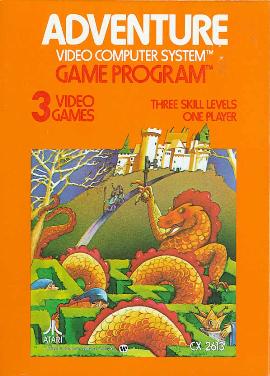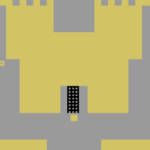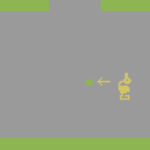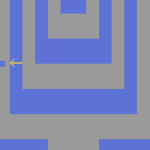Adventure, written by Warren Robinett and released by Atari in 1980, is a fantasy adventure game for the Atari 2600. Using basic graphics, the game allows a player to navigate a series of castles and mazes to recover keys, collect treasures, and slay dragons.
The game plays a pivotal role in Ready Player One, not so much because of its gameplay, but because Robinett hid his name within the game when Atari wouldn’t give him credit for writing it. It was one of the first video game Easter Eggs and inspires the novel’s James Halliday – a programmer and billionaire – to create his own Easter Egg.
The best part is that Easter Egg in Adventure is very much real …and you can still find it, more than forty years later.
Source
It was called Adventure. Like many early videogames, Adventure was designed and programmed by just one person. But back then, Atari refused to give its programmers credit for their work, so the name of a game’s creator didn’t actually appear anywhere on the packaging.
So the guy who created Adventure, a man named Warren Robinett, decided to hide his name inside the game itself. He hid a key in one of the game’s labyrinths. If you found this key, a small pixel-sized gray dot, you could use it to enter a secret room where Robinett had hidden his name. — Ready Player One p. 5
Game Play

Atari’s Adventure featured a square hero, an arrow-shaped sword, and duck-like dragons, but it still managed to inspire a generation of gamers. It also inspired Ready Player One‘s own pop-culture-infused easter egg, providing a tangible MacGuffin to drive the book’s action.
Adventure’s easter egg is worth nothing save for a sense of accomplishment. It consisted of the digital signature of the game’s programmer, scrawled on a castle wall because Atari didn’t give credit to its game programmers.
The game is basic in the extreme – the graphics involve you (a square) questing through various levels looking for relics (e.g. a chalice). Your character – a colored square – can only carry one item at a time. This reduces inventory management to a game of grab and stash, as you find the sword, use it to kill a dragon, then drop it somewhere you can find it again so you can go unlock a door with a key.
Clearing Level 1 was easy, but Level 2 was notably harder, adding invisible mazes, item-stealing bats, and a more extensive adventure layout. The malevolence of the game’s signature duck dragons comes from their hunting ability and not from their visual appeal; someone new to the game would probably think they were mutant avians or perhaps some sort of giant seahorse.
Impressions
I played the game repeatedly as a kid, but it never held my interest in the same way as the text-based adventures of the time (Colossal Cave, Zork, Hitchhiker’s Guide to the Galaxy). I think it was because the imaginative load was simply too high; it was much easier to picture myself crawling through the subterranean realm of Colossal Cave than it was to translate a square into an epic warrior delving into a castle.
The Ready Player One Replay is an exploration of the games that inspired the novel Ready Player One by Ernest Cline.
High Scores
- My high score: I beat the first level, didn’t make it past the second, and didn’t find the easter egg.
Resources
Where to Play
- IGN: Adventure – A free browser-based Adventure emulator hosted by IGN. Requires Adobe Flash
- Internet Archive: Adventure – Another free browser-based emulator, this one hosted by the Internet Archive.
- Atari Flashback Classics for the Switch – A collection of 100 Atari games, including Adventure.
Commentary
- Mediawiki: Adventure
- Warren Robinett: Adventure webpage
- Critical Path – Warren Robinett interview – “The First Easter Egg” (video)
- Forbes: The True Story Behind The Original Video Game ‘Easter Egg’ That Inspired ‘Ready Player One’
- East Coast Destruction BMX – Adventure (Atari 2600): Finding the Hidden Easter Egg (video)
- Ready Player One Subreddit – Warren Robinett answered your questions!
- Inverse: That Atari “Adventure” Easter Egg in “Ready Player One” Exists IRL
How to beat Adventure
- Insane Retro Games: Adventure Walkthrough on the Atari 2600 VCS
- Retro Games Fan: Beating Atari 2600 Adventure in 50 Seconds!
- IGN: Yes, Ready Player One’s Final Challenge Is Real: How the Atari Adventure Easter Egg Works
Resources
- WarrenRobinett.com: Map of Adventure by Warren Robinett (gif)
- AtariAge: Manual for Adventure (images)




